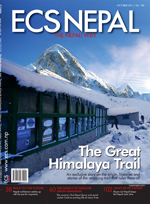East – West
There are close to 250 Himalaya peaks above twenty thousand feet high and they stretch from east to west Nepal. It took some traveling to also realize that these mountains are not the northern border of Nepal; but rather that there is Nepal beyond the Himalaya as well. Now there is a unique idea to build and promote a sixteen hundred kilometer long Great Himalayan Trail (GHT). It will go along the Himalaya from one end of Nepal to the other. There is also a possibility that neighboring countries will then extend it much further both to the east and to the west. What makes the landscape along the proposed GHT so amazing is that the tallest mountains in the world are cut through by mighty rivers, creating some of the deepest valleys and gorges in the world. Combine this with the fact that Nepalis live all over the country, even in the remotest parts, and we have a world class destination for back packers, adventure seekers and people looking for answers to life itself.
 With the adverse impacts of climate change, the people living at the foothills of the Himalaya are considered some of the most vulnerable in the world. Although they have not contributed to creating the problem they will be harmed by its impacts. Such is the global nature of these challenges. One of the greatest benefits of the Great Himalayan Trail will be to provide greater access to these communities and help them adapt to rapid changes in their environment. The east west highway runs through the terai mostly and the middle hills do have a fairly good network of “all weather roads” today; but the mountains only have trails and airfields. These are, on the most part, going north and south. The GHT will also facilitate a lot of trade among mountain communities.
With the adverse impacts of climate change, the people living at the foothills of the Himalaya are considered some of the most vulnerable in the world. Although they have not contributed to creating the problem they will be harmed by its impacts. Such is the global nature of these challenges. One of the greatest benefits of the Great Himalayan Trail will be to provide greater access to these communities and help them adapt to rapid changes in their environment. The east west highway runs through the terai mostly and the middle hills do have a fairly good network of “all weather roads” today; but the mountains only have trails and airfields. These are, on the most part, going north and south. The GHT will also facilitate a lot of trade among mountain communities.
For the trekker, lover of Nepal and mountains, the GHT is going to become a life time quest. Many visitors come to Nepal more than once even now; and GHT is sure to bring them back even more times. We should initiate a special certificate for anyone in the world who actually walks the 1600 kilometers. Like so many great ideas in Nepal, we need to keep a close watch on how GHT gets implemented. We have to be proactive to make sure we do not make the mistakes we made on other trek routes and ensure that the natural and social environments are not destroyed in the process of making money from the GHT.
With this issue of ECS, we enter the eleventh year of the publication. As in the past we bring a wide range of stories and images from across Nepal. From local products like honey to the earth friendly business of reclamation and recycling, the ECS is the place to find insights and new perspectives. We bring you people and personalities who have affected our society in numerous ways. The story of Dr. Chandra Gurung is one such example. Whatever you are doing this month, we hope you make time for the Nepali way.






